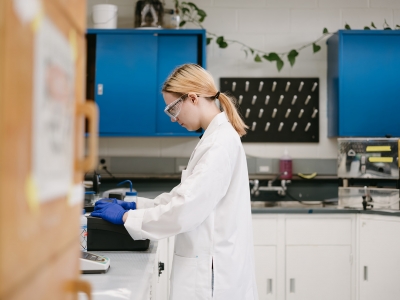Dr. Langis Roy and his team are developing a tiny wireless sensor that can precisely monitor and control X-ray administration in a range of processes. Roy is a Carleton University professor and Associate Dean with the Faculty of Graduate and Postdoctoral Affairs. He and his students are working with the Ottawa-based company Best Medical Canada Ltd., a component of the multi-national Best Medical International, on a sensor embedded in a chip.
If all goes according to plan, the new sensor chip will be used to fully automate the blood irradiation process. Irradiation reduces the risk that patients requiring transfusions will develop the rare but serious complication of graft-versus-host disease, which occurs when white blood cells from the donor blood attack the immune system of the recipient. Irradiating blood makes it safer for transfusion recipients, but blood sometimes has to be discarded if it has been over-radiated. Automating the process will reduce waste and save money.
The team was recently awarded a $25,000 Engage Grant from the Natural Sciences and Engineering Research Council to work with the company, which specializes in developing and manufacturing radiation measurement devices. The grant will allow electrical engineering PhD candidate Behzad Yadegari to continue his work refining and improving a radiation sensor that he created as part of his Master’s thesis. Two other students are now involved. One is working on energy harvesting—so that the device will not require batteries. The other is focused on low-power signal processing.
Roy says CMC Microsystems played an important role, enabling his team to have access to IBM’s 0.13-micron CMOS process. “This RF technology was never intended for X-ray sensors. We adapted it from another process, and quite remarkably, we were able to get it to work.” Over the course of his career, Roy has used a variety of technologies delivered by CMC, including CAD tools, training materials, fabrication services and test equipment.
“We were pioneers in terms of developing complete radios on a chip, including the antenna. Given our expertise and established knowledge, we asked ourselves, “What else could we embed?’ This is how we moved away from pure telecom and circuit applications to wireless sensors.”
He says it has been exciting and motivating for Yadegari to work so closely with Best Medical Canada Ltd. “It has given him workplace smarts, as well as the academic smarts. He is exactly the kind of highly-trained person that Canada needs.”
Roy and his team are hoping to modify the design of the company’s dosimeters and fully automate blood irradiation. Currently, there is room for human error. Operators put the blood in the machine, but occasionally, the blood is over-radiated and must be discarded. The new wireless sensor would tell the machine when to turn off, in addition to providing RFID capability and continuous monitoring of the blood bags. “It is exciting to think we will have an impact on the evolution of this technology,” says Roy.
There are a number of technical challenges ahead. For instance, matching the specific dosage profile to a usable output voltage range of the device requires optimization across a number of performance parameters, including linearity, size and power. Also, integration of the wireless powering and readout functions is particularly difficult to achieve in an efficient manner. The university researchers will continue to draw on resources from CMC as they conduct their work.
From CMC Microsystems, Impact, Feb. 2014



